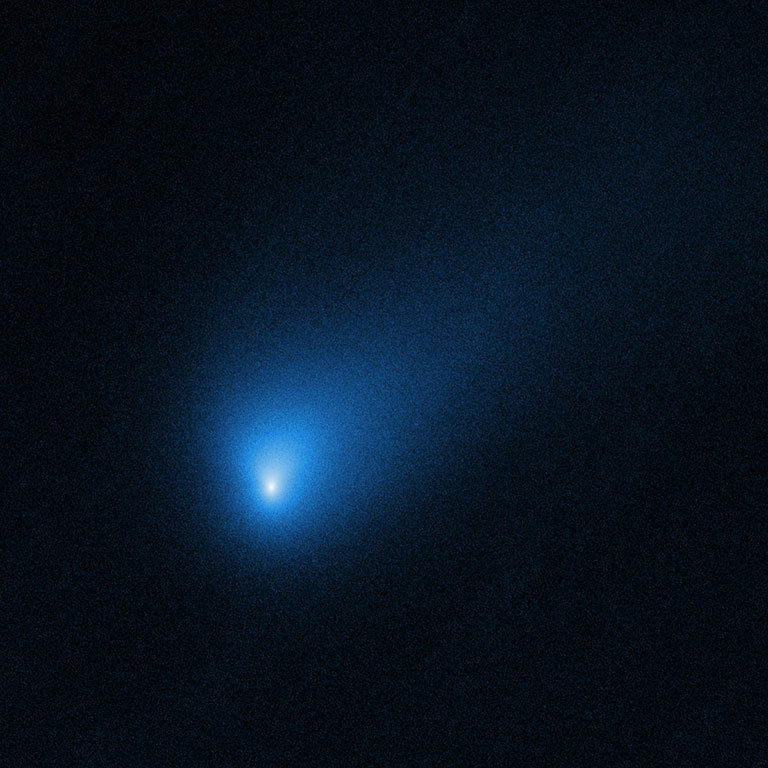Comet 2I/Borisov

In Depth
Comet 2I/Borisov is the first confirmed interstellar comet. It was discovered by Crimean amateur astronomer Gennady Borisov on Aug. 30, 2019, and quickly became a global phenomenon. After a week of observations by amateur and professional astronomers worldwide, scientists determined the path of the fleeting visitor and confirmed it came from outside our solar system.
NASA’s Hubble Space Telescope captured images of comet 2I/Borisov in October and December of 2019, as it streaked through our solar system at a breakneck speed of about 110,000 miles (177,000 kilometers) per hour. The images showed a lot of dust around a bright nucleus, though the nucleus itself was too small to be seen by Hubble.
In March 2020, scientists using Hubble noticed a distinct change in the comet’s appearance: Instead of the single bright inner core spotted in previous images, the images indicated a fragment had broken away from the nucleus. Scientists will continue to use Hubble to monitor the comet.
Only one other visitor from another solar system has been spotted, an object officially named 'Oumuamua. It passed within 24 million miles of the Sun in 2017 before racing out of the solar system. Scientists still aren’t certain whether ‘Oumuamua was an asteroid, a comet or perhaps a hybrid of the two.
"Whereas 'Oumuamua appeared to be a rock, Borisov is really active, more like a normal comet. It's a puzzle why these two are so different," said David Jewitt of the University of California, Los Angeles (UCLA), leader of the Hubble team that observed the comet.
Other comets come mostly from two places: the Kuiper Belt — a donut-shaped region filled with icy bodies beyond the orbit of Neptune, or from the Oort Cloud — the most distant region of our solar system, beginning some 100,000 astronomical units (AU) from the Sun, which contains billions of comets orbiting in a spherical shell. (One AU is the distance between the Earth and Sun — about 93 million miles or 150 million kilometers.)
Size and Distance
Comet 2I/Borisov is estimated to be about 3,200 feet (975 meters) across — or about the length of nine football fields. It’s rapidly moving away from our Sun and will eventually head back into interstellar space, never to return.
Orbit and Rotation
The Sun's gravity is slightly changing comet 2I/Borisov’s trajectory, but it cannot capture it and pull it into orbit because of the comet’s path and its high velocity of about 110,000 miles (177,000 kilometers) per hour.
Structure
Observations by NASA’s Hubble Space Telescope revealed that the heart of the comet is a loose agglomeration of ices and dust particles. In March 2020, astronomers using Hubble saw indications that a fragment had broken off the comet. Follow-up observations using Hubble are planned.
Formation
Comet 2I/Borisov formed in a different star system than our Sun and its family of planets. It could be much older or younger than our 4.5 billion-year-old family of worlds. Many comets that originally formed around our Sun have been ejected from our solar system — mostly due to gravitational encounters with Jupiter. Thus, it's conceivable that Comet 2I/Borisov might also have been ejected from its home in a similar manner.
Surface
We have no direct observations of Comet 2I/Borisov's surface, but comets from our own planetary system have rough surfaces coated in places with smooth blankets of icy, dusty debris.
Atmosphere
Comet 2I/Borisov is too small to hold onto its own atmosphere — it doesn't have enough material (or mass), and thus not enough gravity. However, like most comets that venture closer to the Sun than Jupiter's orbit, Comet 2I/Borisov developed a coma — a dust-filled cloud of gas around the comet's nucleus, created when ices are warmed by solar heating and loft fine dust off the comet's surface and into space.




